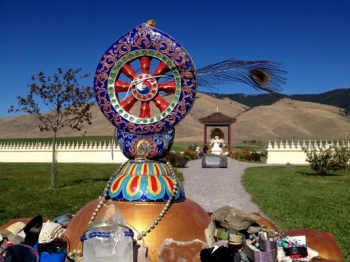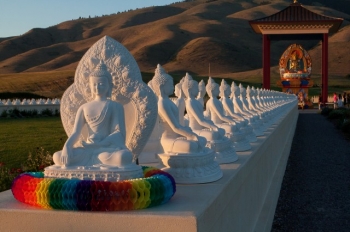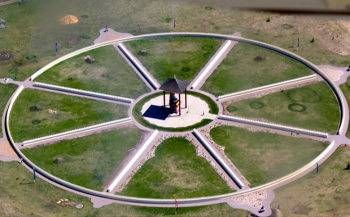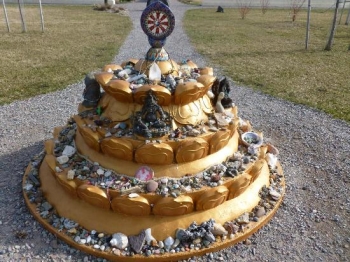The Tibetan Buddhist center Ewam Sang-ngag Ling (EWAM) in Arlee, Montana, is building a garden for peace called the Garden of One Thousand Buddhas. Located on the Flathead Indian Reservation belonging to the Confederated Salish and Kootenai Tribes, EWAM was established in 1993 under the spiritual guidance of its founder, Gochen Tulku Sang-Ngag Rinpoche, a high-ranking lama from the Nyingma school of Tibetan Buddhism.
The garden, which is still under construction, consists of an outer ring of 1,000 stupas containing images of Tara and representing enlightened mind, and an inner ring of 1,000 hand-cast Buddha statues (100 have yet to be cast). The Buddhas surround a 10-foot central figure of Yum Chenmo, the Great Mother, embodying the perfection of wisdom. According to the garden’s website, the physical design “aligns positive properties of the physical world in a sacred architectural arrangement based on the eight-spoke Dharma wheel,” evoking the awakening of wisdom and altruism. The eight spokes, on which the Buddhas rest, represent the eight-fold path of right view, right intention, right speech, right action, right livelihood, right effort, right mindfulness, and right concentration. The garden is intended “to provide visitors of all faiths with an opportunity to generate profound merit, to reduce global negativities, and to bring about lasting peace,” and is designed for circumambulation, although visitors are free to wander at will.
Gochen Tulku Sang-Ngag Rinpoche studied Buddhism secretly in Tibet after the Chinese invasion, which took place when he was just seven. He later spent a decade in prison. The young lama dreamed of going to the United States and spreading Buddhism.
In 1993, Rinpoche visited a sheep farm in Arlee that reminded him of a dream he’d had as a child. “He recognized the land, and other signs pointed him that way,” said EWAM spokeswoman Deborah Hicks in an interview with Kristen Inbody of the Great Falls Tribune. Aided by students and volunteers, Rinpoche set to, and the sheep farm became a peaceful garden.
The garden is further enriched with translations of ancient Tibetan passages in eight languages. Jared Schmidt, a Minnesota State anthropology student and a Lutheran who formerly lived at the center, finds them fascinating. “No matter what angle you look at the garden, there’s always something new to see. It’s wonderful and beautiful,” he told Inbody. “. . . Here we sit on an old sheep farm in this huge tourist corridor in the American West. It's unique in the world and ties together people from around the world.” Brian Sparks, a former Presbyterian minister, volunteers in the garden. “Being together in harmony is what this place is all about. It's a totally distinct culture with reverence for spirituality,” he said.
Over 10 per cent of the Buddha statues have been sponsored by Japanese supporters, at US$200 each. “They really jumped at the chance to get involved,” Hicks said. The Buddhist center also hopes to build a monastery or a temple on the hill, and fundraising for a teaching assembly hall is already under way. There are plans to create flower beds along the garden walls as well.
Hicks stated that everyone who comes to the garden finds enjoyment and returns. “This has a significance as it's one of the only monuments in this country to peace. It's imbued with a feeling. People are mellow and happy when they come [here],” she added.
See more


















